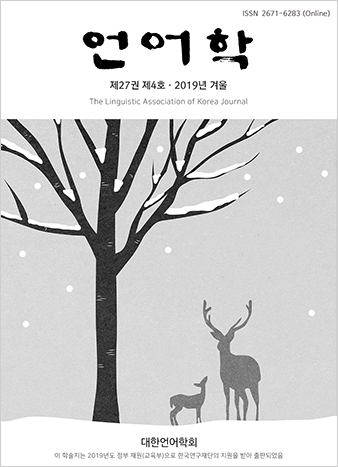대한언어학회 전자저널

-
Anyway as an Unassociative Stance Marker in the American Television Talk Show, Larry King Live
-
Influences of a Native English Teacher and Roles of a Co-teacher on L2 Learners' Learning Styles
-
On the Functions of the Simple Present Tense in The Pilgrim’s Progress
-
Teaching English through Vlogging and In-class Presentation: A Preliminary Comparative Study
27권 4호 (2019년 12월)
- Teaching English through Vlogging and In-class Presentation: A Preliminary Comparative Study
-
Yeismy Jasmin Lazo · Gina Kim
Pages : 105-116
Abstract
Keywords
# technology in class # smart learning # oral presentation # in class presentation # vlogging
References
- Aran, O., Biel, J., & Gatica-Perez, D. (2014). Broadcasting oneself: Visual discovery of vlogging styles. IEEE Transactions on Multimedia, 16(1), 201-215.
- Bandura, A. (1986). Social foundations of thought and action: A social cognitive theory. Englewood Cliffs, NJ: Prentice Hall.
- Brinton, D. (2001). The Use of Media in Language Teaching. Teaching English as a Second or Foreign Language, 459-475.
- Clifton, A., & Mann, C. (2011). Can YouTube enhance student nurse learning? Nurse Education Today, 31(4), 311-313.
- Gao, W., Tian, Y., Huang,T., & Yang, Q. (2010). Vlogging: A survey of video-blogging technology on the Web. ACM Computing Surveys (CSUR), 42(4), 15.
- Grez, L., Valcke, M., & Roozen, I. (2009). The impact of an innovative instructional intervention on the acquisition of oral presentation skills in higher education. Computers and Education, 53, 112-120.
- Hung, S. (2011). Pedagogical applications of vlogs: An investigation into ESP learners’ perceptions. British Journal of Educational Technology, 42(5), 736-746.
- Hsu, H., Wang, S-K., & Comac, L. (2008). Using audio blogs to assist English-language learning: An investigation into student perception. Computer Assisted Language Learning, 21(2), 181-198.
- Jang, B. (2015). Etude sur I'Application de Smart-Learning pour I'enseignement d'une langue etrangere. The Journal of Linguistic Science, 72, 377-396.
- June, S., Yaacob, A., & Kheng, Y. (2014). Assessing the use of YouTube videos and interactive activities as a critical thinking stimulator for tertiary students: An action research. International Education Studies, 7(8), 56-67.
- Jung, S. (2018). Research trends in using blogs for second/foreign language learning and teaching. Multimedia-Assisted Language Learning, 21(4), 57-81.
- Lee, E., & Park, M. (2008). Student presentation as a means of learning English for upper intermediate to advanced level students. Journal of Pan-Pacific Association of Applied Linguistics, 12(1), 47-60.
- Moon, D. (2016). Development and evaluation of an English speaking task using Smartphone and Text-to-Speech. Journal of the Institute of Internet, Broadcasting and Communication, 16(5), 13-20.
- Shih, R. (2010). Blended learning using video-based blogs: Public speaking for English as a second language students. Australasian Journal of Educational Technology, 26(6), 883-897.
- Sun, Y. (2009). Voice blog: An exploratory study of language learning. Language Learning & Technology, 13(2), 88-1-3.
- Wang, Y. (2003). Communication-orientation in freshman English curriculum: A new response. Proceedings of the 12th Conference on English Teaching and Learning in the Republic of China. Taipei, Taiwan: Crane. 588-598.
- International Reading Association. (2013). Oral presentation rubric. Retrieved from http://www.readwritethink.org/files/resources/lesson-416/OralRebric.pdf
- San Jose Area Bilingual Consortium. (2018). Student oral language observation. Retrieved from http://www.cal.org/twi/EvalToolkit/appendix.solom.pdf